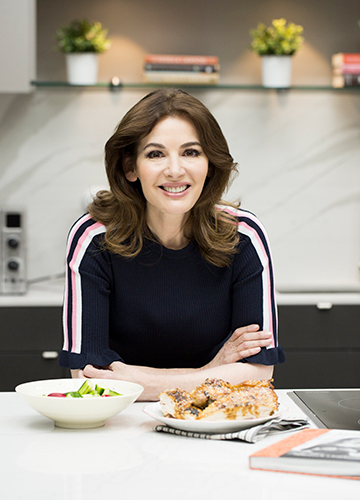Back when the world was younger, the word gastroporn would elicit only one name: Nigella Lawson. The English food writer and cooking show host would often glide and flounce around her kitchen in a satin robe, joking about her ineptness with a knife, licking her fingers and the mixing bowl while rustling up breakfast waffles with all the warmth and gooeyness of a “domestic goddess”.
For the longest time, Lawson was the world’s favourite home chef. Before the internet played killjoy and changed the meaning of food porn into formulaic, precisely-staged, colour-corrected photos. And, then, everyone became a home chef, a food blogger or an Instagram food influencer. “I think a lot of people are very snobbish about all the food online, with people blogging and having everything on Instagram,” said the bona fide queen of food porn at a private dinner she hosted in Delhi on September 15. “I have to say I am someone who really feels that you know—and I think I am in the right country to say this as well—the best food is brown food. The food that has the most flavour is often the least photogenic.”
The six-course meal was hosted at The Roseate, a chic and modernist urban resort in Samalka. Diners paid 025,000 each for the experience, complete with a pre-dinner Q&A. Dressed in a close-fitting cocktail dress with fluorescent green stripes and in beige heeled pumps, Lawson, 59, is as alluring with her “chocolatey eyes” and “raven tresses” as one remembers her from shows like Nigella Bites and Nigella Kitchen. But, she is also flowing with the current and knows there is enormous aesthetic pleasure in a good photograph. “I love photographing, to such an extent that I have developed my own food photography app,” said Lawson, who noticed early on how there was no dedicated food photography app and the general ones could not elevate food. So, her app, Foodim, comes with built-in filter and depth-of-field to optimise food and back-of-shot blur. A classic example of what-you-can’t-find-for-yourself-you-invent.
Lawson must have followed the same principle when she wrote he first book, How To Eat, in 1998. The book was a heartfelt, brave and philosophical ode to food and cooking; it exhorted readers to eat only to please themselves before anyone else. Her distinctive voice as a debut author, after a career as restaurant critic and book reviewer, made a case for guilt-free, pleasure-seeking, carefree attitude to food. That one could be shamelessly greedy in their kitchen. And a bowl of vegetables are as indispensable as butter, cheese or goose fat. When questioned about her unabashed love for butter at the dinner, she dispensed wisdom that is mighty helpful in an age of too much information and too many health fads. “I never, never feel guilty. And in fact I feel very, very strongly that those of us who are lucky to eat wonderful food should only feel guilty if we don’t take pleasure in it,” she said.
It is interesting how the word “balance” is Lawson’s guiding doctrine in negotiating the old and the new. While she loves the theatricality and sensationalism of avant-garde food in mind-boggling restaurants, she knows real food is about repetition, memory, connections and tables at many homes. While there is a phenomenally boastful food traffic online, the digital sphere also has the “warmth of a village square” with people sharing and swapping recipes, a boon for home cooks globally. Her curated dinner menu had old favorites like salted chocolate tart with new concoctions like warm spiced cauliflower and chickpea salad with pomegranates and Halloumi cheese. When the emcee for the evening recalled that the British writer Nigel Slater had called Lawson the “queen of the frozen pea”, the diva is quick to declare how she has moved on. Then, for an instant, she gazed back admiringly and said: “Oh, that’s an old accolade, but I am still fond of it.”


